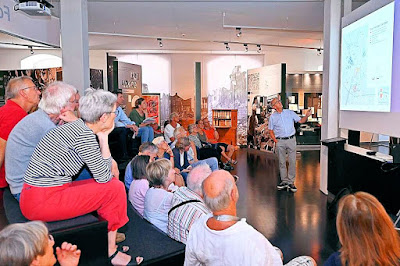The aim of a guided tour offered by the Badische Zeitung as part of their BZ vacation campaign was to visit out-of-the-way or hidden-from-view places at Freiburg's university.
Our group's* guide was Rudolf-Werner Dreier. He is the retired head
of communications and press spokesman for the university and the university
hospital, and recently wrote a book "Universität Freiburg."
*we were 27

|
| ©Thomas Kunz/BZ |
Above are some basic facts and current data. Read more about the foundation of the Albertina in German.

|
| Standing wide-legged, Red Baron listens skeptically as usual (©Thomas Kunz/BZ) |
Starting in 1577, Freiburg's university resisted the influence of the Jesuits for more than 40 years. But in the early days of the 30-Years' War and with the universities of Basel, Strasbourg, and Tübingen dominated by Protestants, the defensive struggles no longer stood a chance. The "Sozietät" fathers began teaching the "right faith" in 1620. The University of Freiburg became the bulwark of Catholicism on the Upper Rhine. You may like to learn more about the struggle in German.
The Jesuit church, built in the baroque style of the Counter-Reformation, was consecrated in 1701. After the abolition of the Jesuit Order in 1773, the church passed to the University of Freiburg in 1793. It was destroyed during the war and rebuilt without baroque frills at the end of the nineteen fifties.
Today the interior is dominated by the five-and-a-half-meter monolithic Christ figure hanging from a steel girder. In the beginning, Franz Gutmann's sculpture showing a huge crown of thorns instead of a head caused fierce controversies. That is long forgotten.
With Napoleon's creation of the Grand Duchy of Baden, the university's existence was in danger for financial reasons.
The next stop was the third floor of the new University Library (UB). Mr. Krause, head of the University Media Center, proudly showed us batteries, audio recording equipment, and professional cameras that students can borrow for video productions of a thesis.
Fourth stop, the Haus zu lieben Hand. In the late Middle Ages, the rich monasteries in Freiburg's surroundings had residences in the city. With the secularization at the beginning of the 19th century, the buildings often fell to the university.
For example, the Haus zur lieben Hand served as a town residence for the provost of the Benedictine monastery of St. Gall, who had his duty station in Ebringen. The building is now used for colloquia and symposia. The cellar of the house is still preserved in its original state.
Another example is the Peterhof, the last stop of our guided tour. The extensive building complex was the town residence of the abbot of the monastery of St. Peter in the Black Forest. It now holds university offices.
_02.jpg)
|
| ©Joergens.mi/Wikipedia |




No comments:
Post a Comment